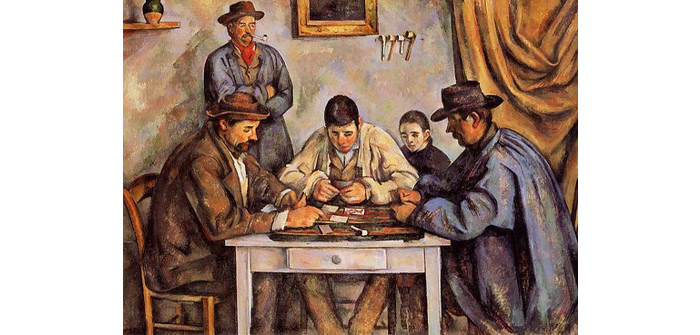“Paul Cézanne – The card-players”
For centuries, artists have been drawn to games of chance both as a subject of their art and as an activity in itself. It’s featured across everything from paintings to novels, and from high art to popular culture. Because of this, there have been many theories put forward as to why, exactly, it continues to be such a popular muse.
Of course, art reflects life, and gambling has played a part in society almost since time immemorial. So perhaps we shouldn’t also be too surprised when it is found to be the subject of an artist’s work. Take, for example, Caravaggio’s The Cardsharps. As a painter in Italy in the 16th century, this will have been a scene with which the famed artist was more than familiar.
Similarly, Cézanne’s famous series of paintings showing The Card Players will have been influenced by the world in which the post-impressionist found himself. Even Edvard Munch, best known for The Scream, was stirred to paint a game of roulette in the casino in Monte Carlo, following a stay in the South of France in the 1880s.
While these may all be considered to be classic masterpieces, contemporary artists are also drawn to gambling. A prime example is the very popular British artist Beryl Cook who is famous for her exaggerated representations of everyday life; whether it’s days at the seaside or other leisure activities. Cook is known to have painted many a casino scene, with her painting of a roulette game being very well-received.
But far better known is her painting of ladies sitting down to a game of bingo. Even though the original was painted in the 1970s, the rise of online bingo and its increasing popularity over the last few years, gives the work even more relevance today.
Today, the legacies of classic gambling and bingo have transpired over both art, and into digitalised offerings, such as slots and jackpot bingo games that can be found of sites like Paddy Power. The progression of the industry, in both life and art, thus illustrates that the innate human interest in the pastime shows no signs of wavering.
Because of this, we can see that gambling has not simply been a subject for artists, a number have also enjoyed it immensely as an activity too. Of contemporary painters, Lucien Freud is perhaps the best known of this group. A devotee both of casinos and visits to the horse track, he was even known to use some of his paintings to fund bets. Admittedly, this was in his earlier days as an artist when still relatively unknown. Later in life, his work commanded such high prices that lack of cash was never an issue.
One could also argue that the art market as a whole has close links with gambling. After all, when collectors like Charles Saatchi hone in on young artists and buy up their work, what else are they doing but wagering that it will increase in value over time?
But above all, one of the most obvious links between gambling and art is the embracing of risk itself. In making any piece, its creator is taking a number of chances. Firstly, there’s the question about whether the finished piece will be as they first envisaged it. Then there’s the risk of it not being understood, or not being liked by their intended audience. By launching themselves into this world of uncertainty, they are playing for very high stakes indeed.

